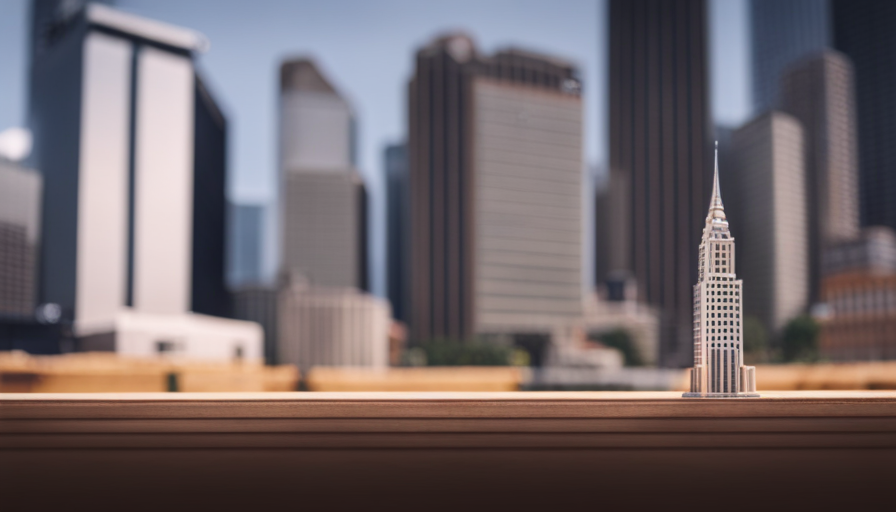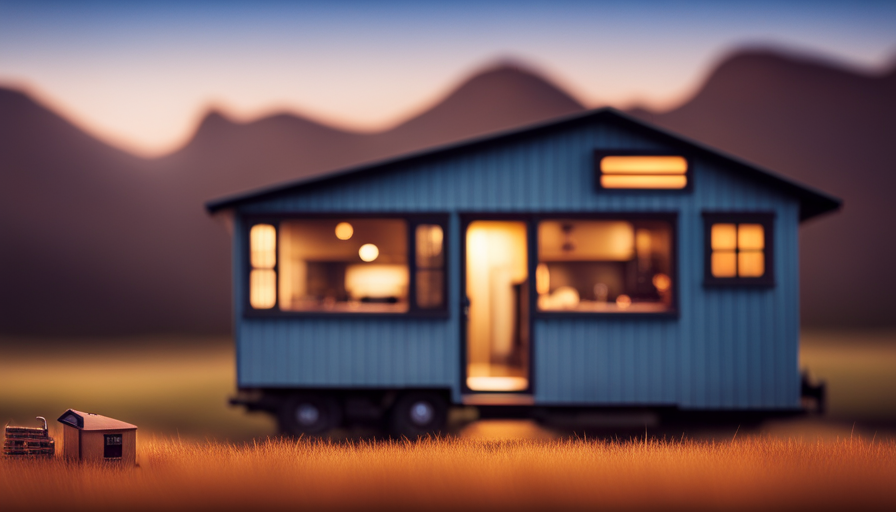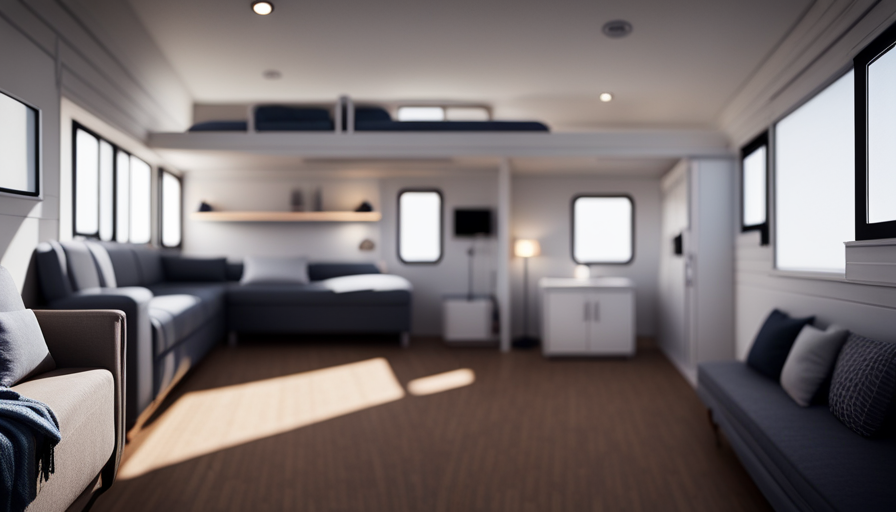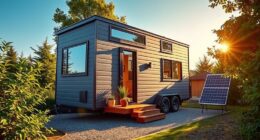Congrats on choosing to construct a tiny home! Now comes a big question: How tall should it be? This might sound easy, but trust me, it’s far from straightforward.
This seemingly innocent choice has far-reaching implications, from legal restrictions and building codes to practicality and functionality. And let’s not forget about design preferences, aesthetics, and even height limitations for transport and mobility. Oh, and did I mention interior space and comfort? Yes, every inch matters when it comes to your tiny house.
But fear not, for I am here to guide you through this labyrinth of decisions. In this article, we will explore all the factors you need to consider, consult with professionals, and research existing designs to help you make an informed decision.
So, buckle up and get ready to discover the perfect height for your tiny abode.
Key Takeaways
- Understanding legal restrictions and building codes is important to ensure compliance and a smooth building process.
- Consulting with local authorities is essential to be informed about specific building codes and permits required.
- Assessing the practicality and functionality of the design involves considering the cost, structural stability, and functionality of the tiny house.
- Maximizing natural lighting and ventilation creates a bright and airy living space.
Understanding Legal Restrictions and Building Codes
When it comes to building a tiny house, it’s important to understand the legal restrictions and building codes in order to ensure compliance and a smooth building process. Understanding zoning regulations and consulting with local authorities is crucial to avoid any potential legal issues and setbacks.
Zoning regulations vary from one area to another, and they dictate where and how you can build your tiny house. Some areas may have specific requirements for the size, height, and location of the house, while others may have restrictions on utilities and parking. By familiarizing yourself with these regulations, you can ensure that your tiny house meets all the necessary criteria.
Consulting with local authorities is also essential to ensure that you are well-informed about any specific building codes or permits required in your area. Building codes are designed to ensure the safety and structural integrity of the house, and they cover various aspects such as electrical systems, plumbing, insulation, and fire safety. By following these codes, you can ensure that your tiny house is safe and up to standard.
Understanding the legal restrictions and building codes is just the first step in building a tiny house. The next section will focus on assessing the practicality and functionality of your design, taking into consideration factors such as space utilization and storage options.
Assessing Practicality and Functionality
Consider the practicality and functionality of your cozy abode to ensure it fulfills your every desire. When building a tiny house, it’s crucial to assess the cost and analyze the structural stability of your design. Here are three key factors to consider:
-
Cost: Take into account the overall budget for constructing your tiny house. Consider the expenses for materials, labor, permits, and any additional features or amenities you desire. It’s important to strike a balance between your budget and the functionality of your tiny house.
-
Structural Stability: Assess the strength and durability of your design. Consider the materials used for the foundation, walls, and roof. Ensure that your tiny house can withstand various weather conditions and is built to last. Consulting with a structural engineer can provide valuable insights and ensure your tiny house is safe and stable.
-
Functionality: Evaluate the layout and design of your tiny house to optimize its functionality. Consider the placement of windows for natural light, storage solutions to maximize space, and efficient use of utilities such as plumbing and electrical systems. By carefully assessing these factors, you can create a comfortable and functional living space.
Considering the practicality and functionality of your tiny house is just the beginning. Next, we’ll delve into considering design preferences and aesthetics to make your cozy abode truly unique.
Considering Design Preferences and Aesthetics
Exploring your personal style and aesthetic choices can add a touch of individuality to your charming retreat. When considering the design preferences for your tiny house, it’s essential to think about the overall look and feel you want to achieve.
Do you prefer a modern and minimalist style or a more rustic and cozy atmosphere? Understanding your aesthetic considerations will guide your decision-making process and help create a space that reflects your unique personality.
One aspect to keep in mind is the size and scale of the design elements. In a tiny house, every inch matters, so it’s crucial to choose furnishings and decor that fit well within the limited space. Opting for multi-functional furniture pieces can maximize functionality and save space. Additionally, selecting a color palette that complements your style can enhance the overall ambiance of your tiny home.
As you explore different design options, consider how they align with your lifestyle and practical needs. For example, if you enjoy cooking, a well-equipped kitchen may be a priority for you. Conversely, if you spend most of your time outdoors, you might prioritize an open floor plan that seamlessly connects indoor and outdoor living spaces.
By carefully considering your design preferences and aesthetic considerations, you can create a tiny house that not only meets your functional needs but also feels like a true reflection of your personal style.
Next, we will delve into evaluating height limitations for transport and mobility, ensuring your tiny house is not only beautiful but also practical for any future moves.
Evaluating Height Limitations for Transport and Mobility
Unfortunately, there’s no need to worry about the height limitations of your mobile abode because who doesn’t enjoy the stress and hassle of trying to navigate under low bridges and through tight spaces?
Evaluating the structural integrity and weight distribution of your tiny house is a crucial step in ensuring a smooth and safe transport. To properly evaluate the height limitations, it is important to consider the overall weight of the house and the distribution of that weight. This includes analyzing the placement of heavy furniture, appliances, and other fixtures that could potentially affect the balance and stability of the structure during transportation.
In terms of weight distribution, it is important to evenly distribute the load throughout the tiny house to prevent any strain on the structure. This can be achieved by placing heavier items closer to the center of the house and securing them properly.
Additionally, evaluating the structural integrity involves assessing the materials used and the overall design of the house. Ensuring that the walls, roof, and foundation are sturdy and well-built is essential for a tiny house that can withstand the rigors of transportation.
Taking into account interior space and comfort, it is important to carefully plan the layout and design of the tiny house. By optimizing the use of space and incorporating smart storage solutions, you can create a comfortable and functional living environment.
Taking into Account Interior Space and Comfort
To create a comfortable living environment, it’s important to take into account the interior space and incorporate smart storage solutions. Maximizing storage is essential in a tiny house because it allows for better organization and utilization of the limited space available.
By optimizing the layout, you can create a functional and efficient living area. One way to achieve this is by using multifunctional furniture, such as a sofa that can convert into a bed or a dining table that can double as a workspace.
Additionally, utilizing vertical space can greatly increase storage capacity. Consider installing shelves or cabinets that go all the way up to the ceiling. This not only maximizes storage but also helps to create a visually appealing aesthetic.
Another important aspect to consider is the flow of the house. Make sure there is enough space to move around comfortably without feeling cramped. By carefully planning the layout and incorporating smart storage solutions, you can create a tiny house that feels spacious and comfortable.
Transitioning into the subsequent section about determining ceiling height for multi-level tiny houses, it’s crucial to consider the overall design and functionality of the space.
Determining Ceiling Height for Multi-Level Tiny Houses
Determining the ceiling height for multi-level tiny houses can significantly impact the overall design and functionality of the space. Studies show that higher ceilings can create a sense of openness and make a small space feel larger. However, it’s important to consider structural integrity and cost implications when deciding on the appropriate ceiling height.
Structural integrity is a crucial factor to consider when determining the ceiling height of a multi-level tiny house. The height of the ceiling affects the weight distribution and load-bearing capacity of the structure. A higher ceiling may require additional support beams or reinforcements to ensure the safety and stability of the house. It’s essential to consult with a structural engineer to determine the appropriate ceiling height that’ll maintain the integrity of the building.
Cost implications also come into play when deciding on the ceiling height. Higher ceilings require more materials and labor, which can increase construction costs. Additionally, a taller ceiling may require specialized equipment or techniques for installation. It’s essential to consider these cost factors and balance them with the desired aesthetic and functionality of the space.
When factoring in natural lighting and ventilation, it’s important to consider the height of the windows and the placement of openings. By strategically positioning windows and incorporating skylights or clerestory windows, natural light can be maximized, reducing the need for artificial lighting. Properly placed windows and openings also promote airflow and ventilation, creating a comfortable and healthy living environment.
Transitioning into the subsequent section about factoring in natural lighting and ventilation, it’s important to consider the impact of these elements on the overall design and functionality of a multi-level tiny house.
Factoring in Natural Lighting and Ventilation
Maximizing natural lighting and ventilation is crucial for creating a bright and airy living space in your multi-level tiny house. When designing the layout, it is important to consider how to maximize the amount of natural light that enters the space. This can be achieved by strategically placing windows and skylights in areas where they will receive the most sunlight throughout the day. Additionally, using light-colored materials for walls and ceilings can help reflect and amplify the natural light.
To optimize air flow, it is essential to carefully plan the placement of windows and doors. This will allow for cross ventilation, helping to keep the space cool and fresh. Furthermore, incorporating features such as ceiling fans or vents can aid in circulating the air and preventing stuffiness.
To better illustrate the importance of maximizing natural lighting and optimizing air flow, consider the following table:
| Benefit of Natural Lighting | Benefit of Optimized Air Flow | Result |
|---|---|---|
| Increased mood and productivity | Reduced humidity and odors | Enhanced living experience |
| Energy savings from reduced need for artificial lighting | Improved air quality | Healthier living environment |
| Enhanced connection to the outdoors | Decreased risk of mold and mildew | Longer lifespan of the tiny house |
By taking these factors into account, you can create a comfortable and inviting living space. Consulting with professionals and experts will further ensure that your design is effective in maximizing natural light and optimizing air flow.
Consulting with Professionals and Experts
After factoring in natural lighting and ventilation, the next step in determining the height of my tiny house is to consult with professionals and experts. This is crucial as it will provide me with valuable insights and guidance on how high I should build my tiny house.
One important aspect to consider when consulting with professionals is the cost implications. Building a tiny house involves various expenses, and the height of the structure can significantly impact the overall budget. Professionals will be able to provide accurate estimates and help me make informed decisions regarding the height that best suits my budget.
Additionally, consulting with experts will help me consider the environmental implications of my tiny house’s height. The height can affect the energy efficiency of the house, as well as its impact on the surrounding environment. Experts can advise on strategies to maximize natural resources, such as solar energy and rainwater harvesting, based on the height of the house.
By consulting with professionals and experts, I will gain a comprehensive understanding of the cost implications and environmental considerations associated with the height of my tiny house. This knowledge will be invaluable in making informed decisions about the height of my tiny house. Moreover, it will lay the foundation for researching existing tiny house designs and height specifications in the subsequent section, ensuring that I create a structure that meets my needs and aligns with my vision.
Researching Existing Tiny House Designs and Height Specifications
To find the perfect design and height specifications for my dream tiny home, I took some time to explore existing models and gathered inspiration from experienced builders and designers.
Researching design concepts, I looked at a variety of tiny house styles, such as modern, rustic, and minimalist. I studied different floor plans and layouts to determine what would work best for my specific needs and preferences. This involved examining the size and placement of windows, doors, and storage spaces. Additionally, I considered the overall aesthetic appeal and functionality of each design.
Exploring construction materials was equally important. I investigated various options, including wood, steel, and sustainable materials like recycled or reclaimed materials. Each material has its own advantages and disadvantages, such as cost, durability, and environmental impact. By understanding these factors, I was able to make informed decisions about which materials to incorporate into my tiny house.
Researching existing tiny house designs and height specifications allowed me to gather valuable inspiration and knowledge. This information helped me make an informed decision based on my specific needs and circumstances.
Making an Informed Decision Based on Your Specific Needs and Circumstances
When considering your unique requirements and situation, it’s crucial to gather all the necessary information to make an informed decision about your ideal tiny home design. Two essential factors to consider are making budget and understanding zoning regulations. By carefully considering these factors, you can ensure that your tiny house meets your needs while complying with local regulations.
To begin, it’s important to establish a budget for your tiny house project. This includes not only the cost of construction but also ongoing expenses such as utilities and maintenance. By setting a budget, you can determine the size and features of your tiny house that are feasible for your financial situation.
Additionally, understanding zoning regulations is crucial to ensure that your tiny house is allowed in your desired location. Different areas have different regulations regarding the height and placement of tiny houses. Researching and contacting local authorities will help you determine any restrictions that may affect the height of your tiny house.
To better visualize the considerations involved in making an informed decision about the height of your tiny house, refer to the table below:
| Considerations | Importance |
|---|---|
| Budget | High |
| Zoning | High |
| Personal Needs | Medium |
| Aesthetics | Low |
| Future Plans | Low |
By carefully considering these factors, you can make an informed decision about the height of your tiny house that aligns with your budget and complies with zoning regulations.
Frequently Asked Questions
How much does it cost to build a tiny house and what are the factors that contribute to the overall cost?
When considering the cost of building a tiny house, several factors come into play. These cost factors include the size of the house, the materials used, the location, and the level of customization desired.
Budget planning is crucial to ensure that all expenses are accounted for, such as permits, labor costs, utilities, and interior furnishings. By carefully considering these factors and creating a detailed budget, individuals can determine the overall cost of building their tiny house.
Are there any specific requirements or restrictions for building a tiny house in rural areas compared to urban areas?
When it comes to building a tiny house, it’s crucial to be aware of the contrasting zoning requirements and building codes between rural and urban areas.
In rural areas, there is often more flexibility in terms of height restrictions, allowing for a loftier establishment. However, urban areas may have stricter limitations due to space constraints and the need to maintain a cohesive aesthetic.
Familiarizing yourself with these regulations will ensure a smooth and compliant construction process.
What are the options for financing a tiny house build and are there any grants or loans available?
There are several alternative financing options available for building a tiny house, including grants and loans. Grants are a great way to receive funding for your project without the need for repayment. There are various grants available from government agencies, non-profit organizations, and foundations that support affordable housing initiatives.
Additionally, loans specifically designed for tiny house builds are offered by some financial institutions. These options provide individuals with the necessary funds to start their tiny house journey.
How do I determine the right size for my tiny house to ensure it meets my needs without sacrificing comfort?
To determine the right size for my tiny house and ensure comfort, I need to consider my lifestyle and space requirements.
One interesting statistic is that the average tiny house size is around 400 square feet.
To begin, I should create a list of essential features and prioritize them based on importance.
Additionally, I can use online tools or consult with professionals to design a layout that maximizes space efficiency.
By carefully planning, I can create a comfortable living environment within my desired size constraints.
Are there any additional considerations or challenges to be aware of when building a multi-level tiny house compared to a single-level design?
When building a multi-level tiny house, there are additional challenges to consider due to space limitations. One major consideration is the structural integrity of the building. The weight of multiple levels can put strain on the foundation and walls, requiring reinforcement.
Additionally, vertical space must be optimized to ensure each level is functional and comfortable. This may involve careful planning of staircases or ladders, as well as creative storage solutions to maximize usable space in a compact design.
Conclusion
In conclusion, determining the height of your tiny house requires careful consideration of legal restrictions, practicality, design preferences, and transportation limitations. It’s essential to consult with professionals and research existing designs to make an informed decision that suits your specific needs and circumstances.
Balancing interior space and comfort, natural lighting and ventilation, while adhering to building codes can be a challenge. However, by weighing these factors and utilizing your creativity, you can create a tiny house that’s both functional and aesthetically pleasing.
Hi, I’m Emma. I’m the Editor in Chief of Tiny House 43, a blog all about tiny houses. While tree houses are often associated with childhood, they can be the perfect adult retreat. They offer a cozy space to relax and unwind, surrounded by nature. And since they’re typically built on stilts or raised platforms, they offer stunning views that traditional homes simply can’t match. If you’re looking for a unique and romantic getaway, a tree house tiny house might just be the perfect option.










